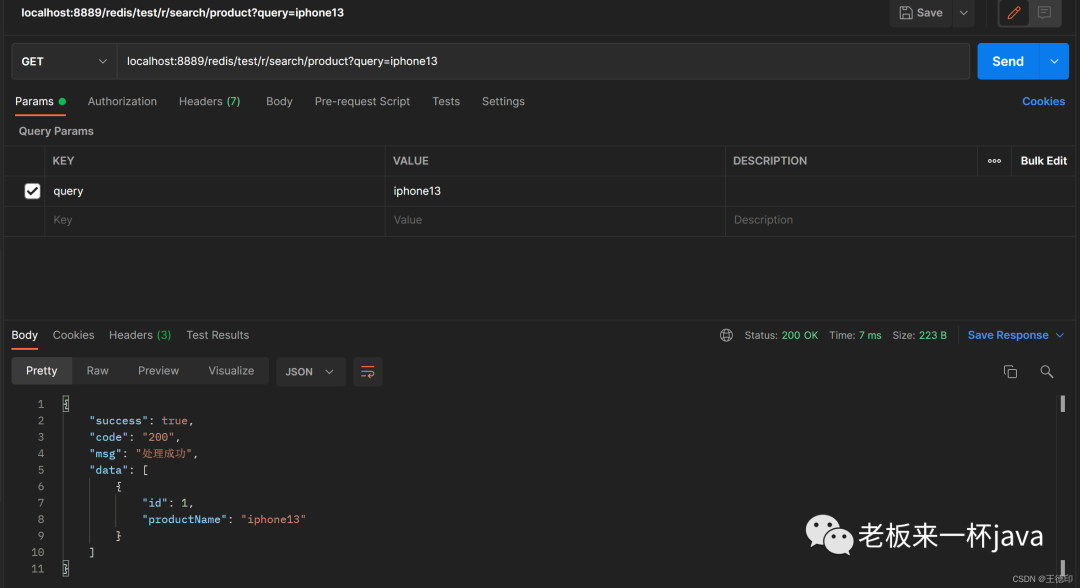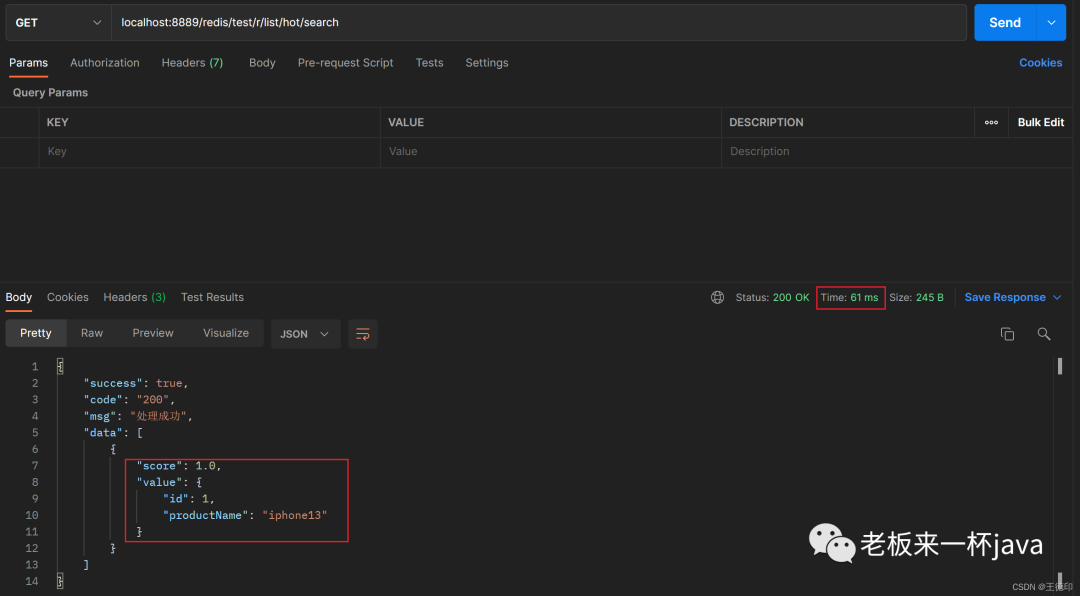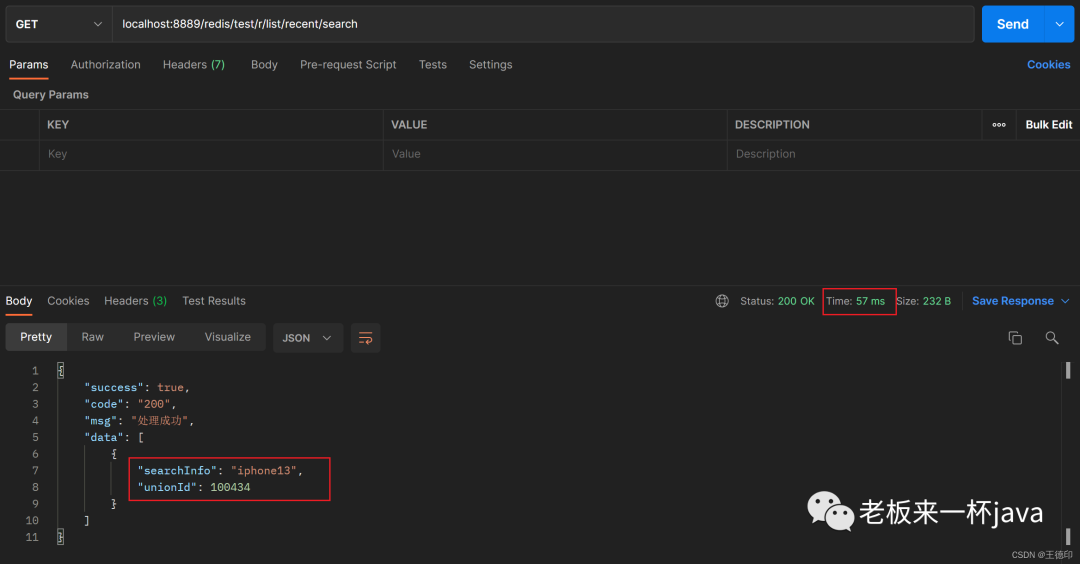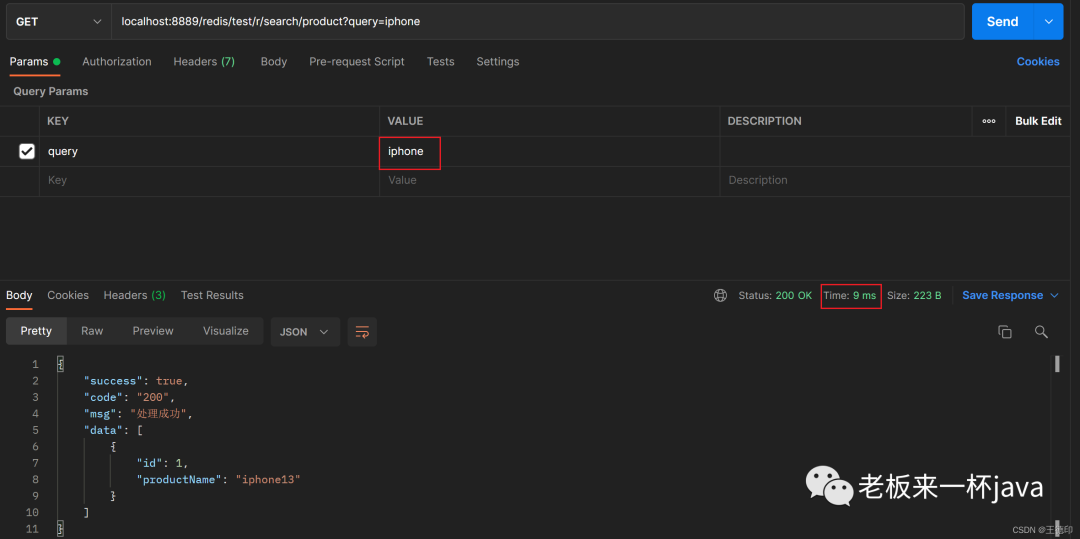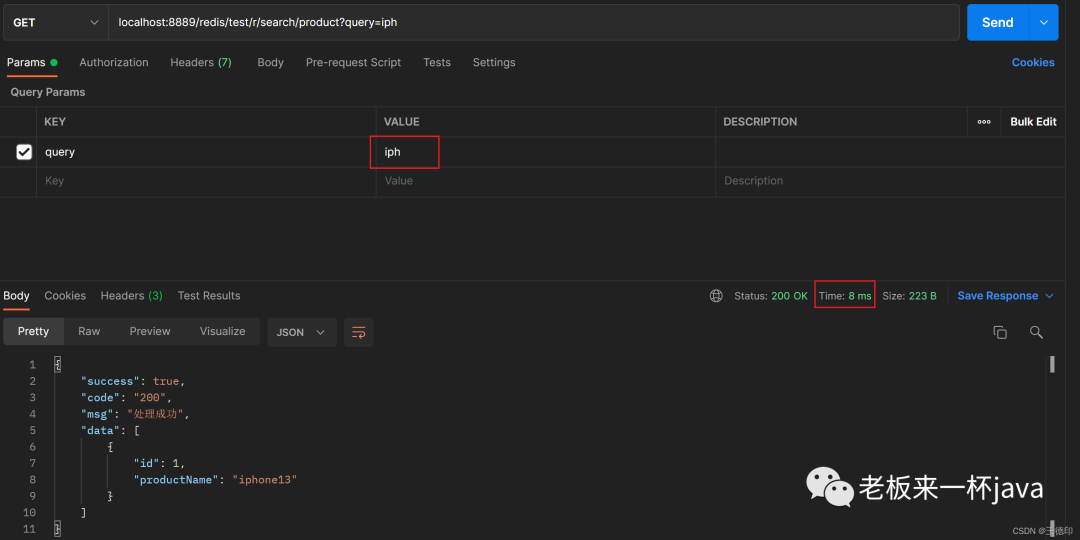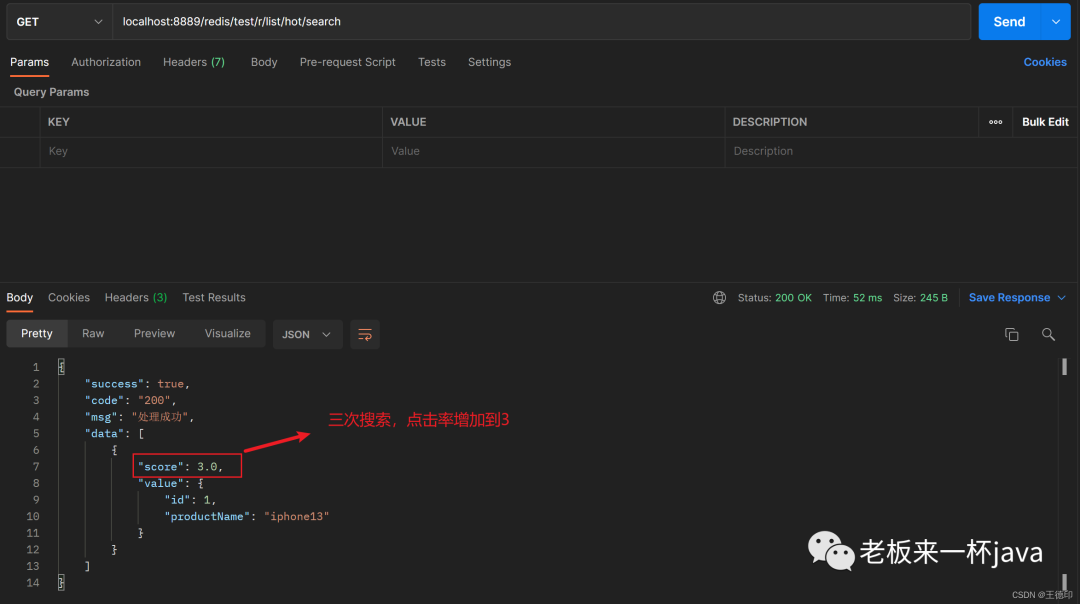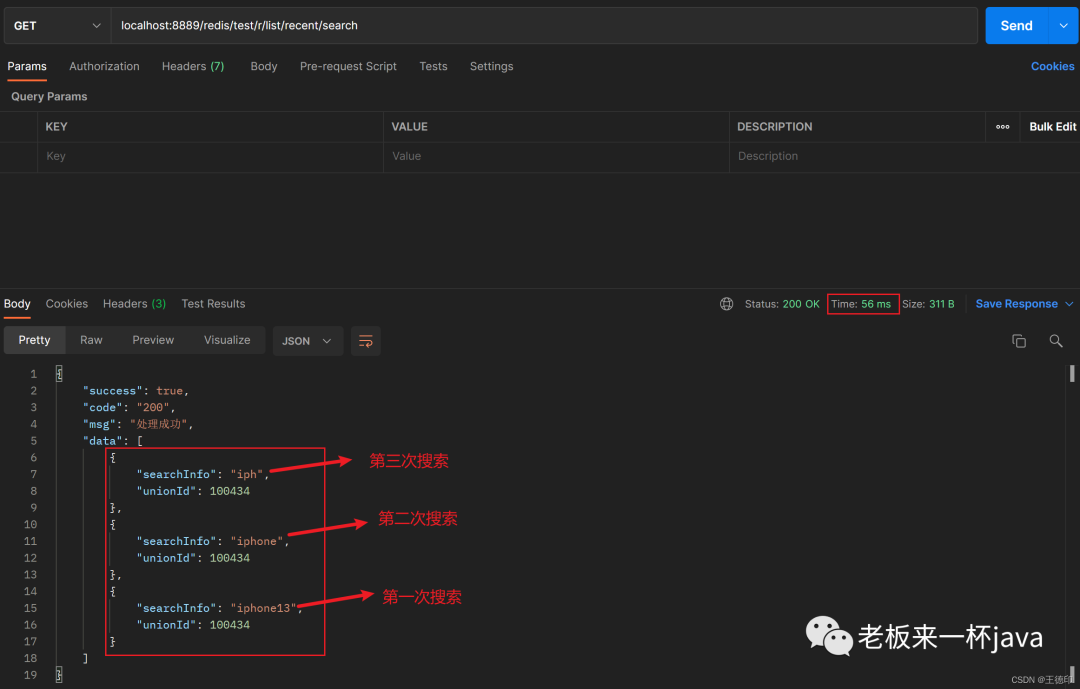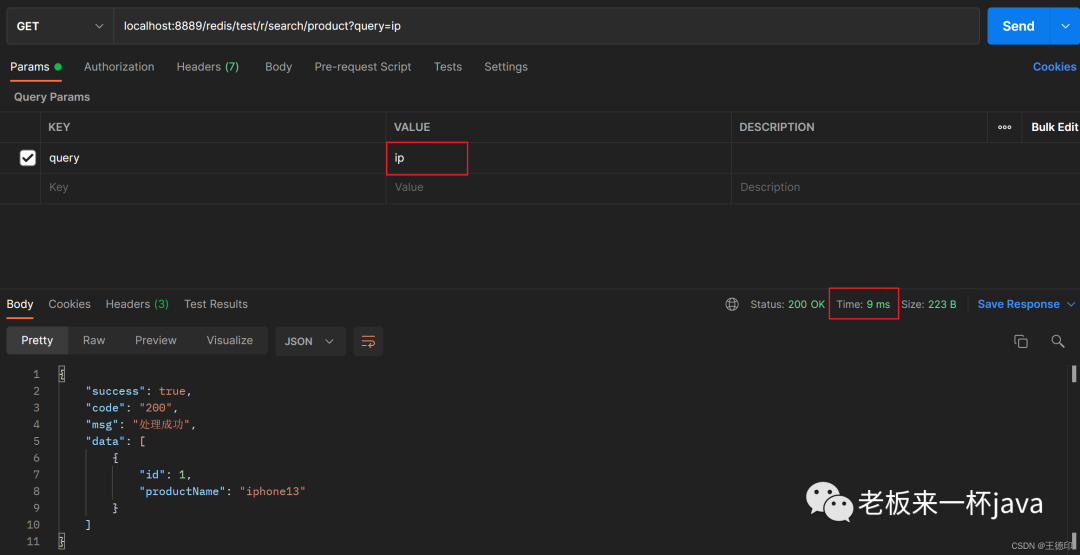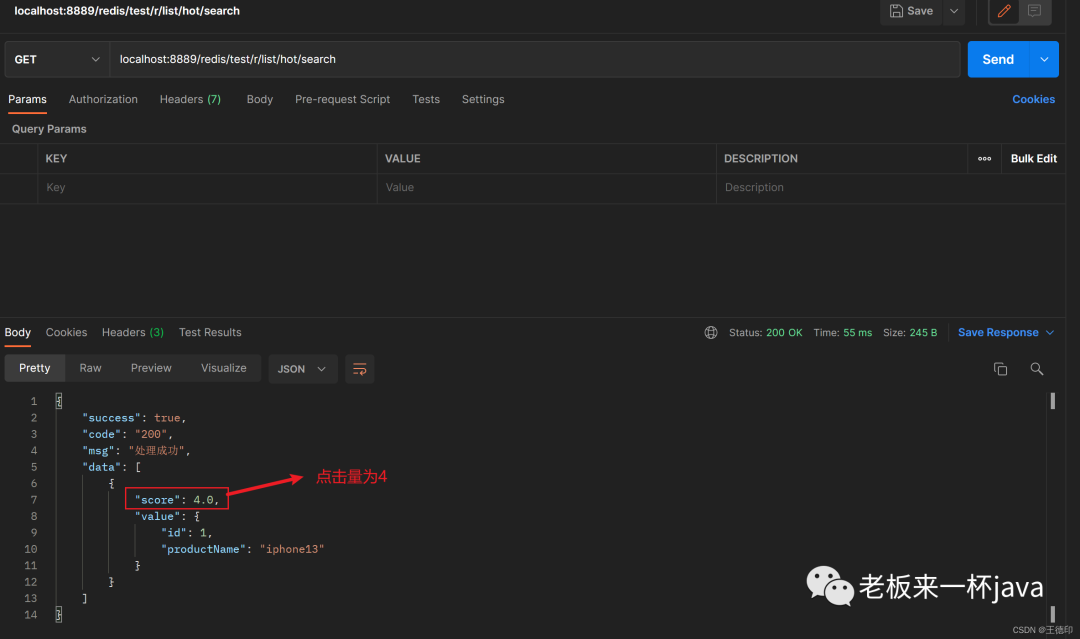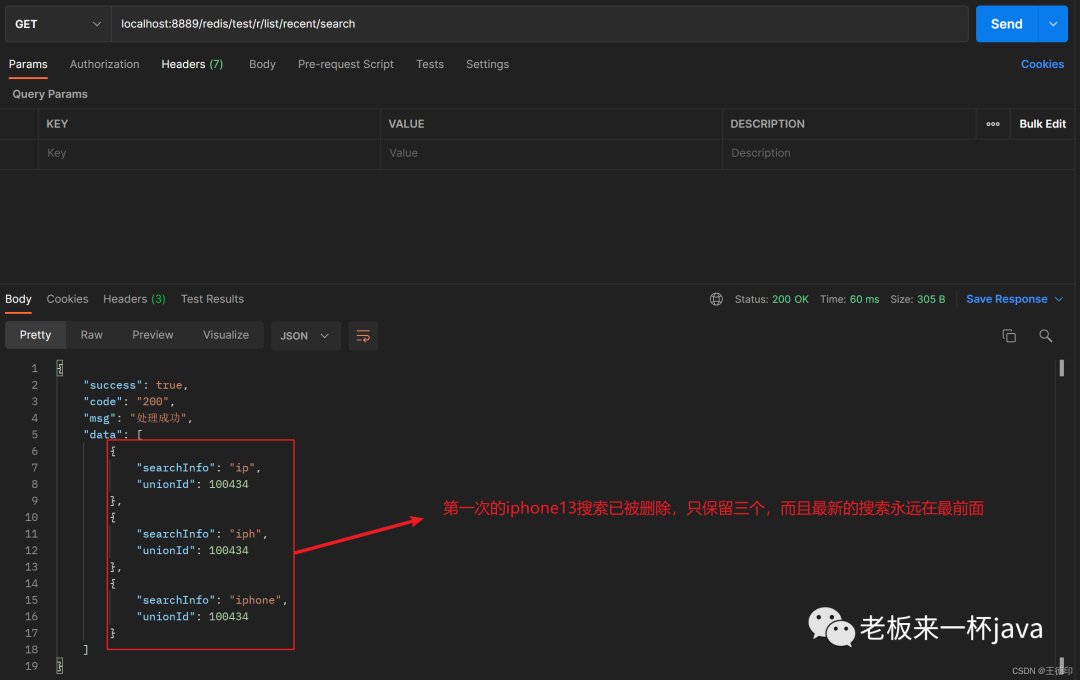一、引入问题
大家在浏览各种网站,比如淘宝,京东,微博等网站,都会看到一些热门搜索和最近搜索的功能,大家有木有好奇,技术背后是如何实现的呢?今天我们一起来用redis解决这两个问题,并已在项目中实战!!!
热搜如下图:
最近搜索如下图: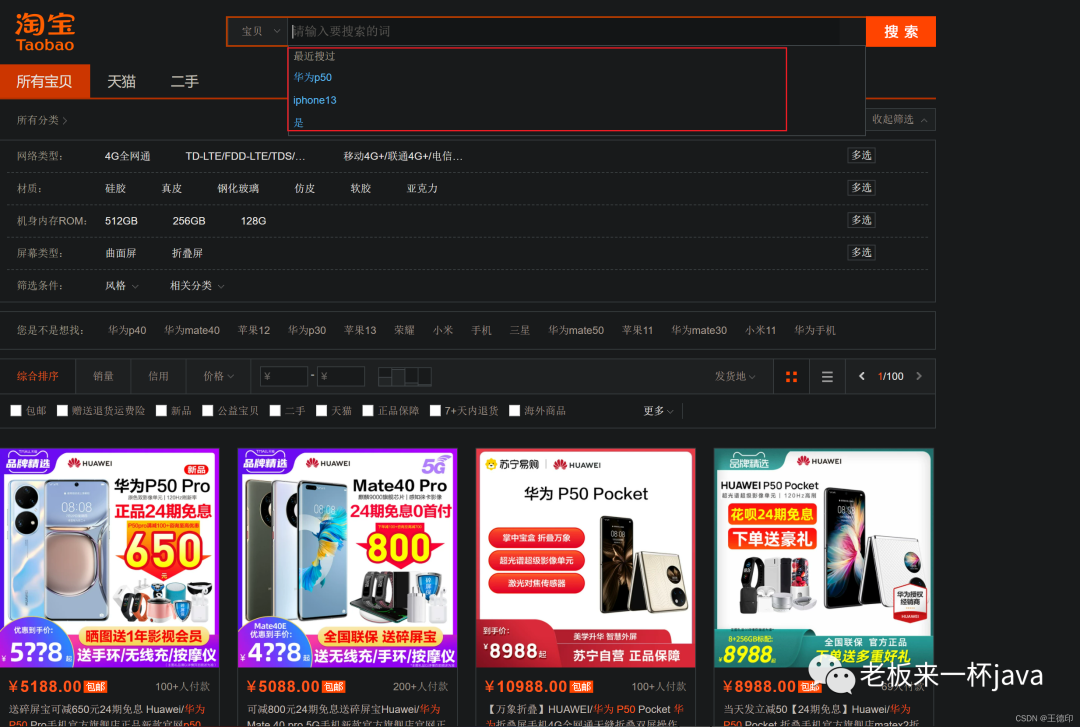
二、分析问题
1.热门搜索:是指一定时间、一定范围内,公众较为关心的热点问题,被搜索的次数越多,热搜榜越靠前。
2.最近搜索:是显示当前用户最近一段时间内搜索的记录,按照时间进行排序,如果有重复搜索,覆盖到重复的数据,并且要排到最前面。
3.针对于热门搜索属于高并发的场景,还需要高性能显示给用户,用Mysql存储显然不合适,流量过大会把mysql撑爆,最近搜索和热门搜索也不需要持久化,最好的解决方案之一就是redis做缓存,单机redis可以承受10万QPS。
三、针对于以上两个问题,使用redis怎么解决呢?
1. 字符串String
特性:
(1)最基本的数据类型,二进制安全的字符串,最大512M。
(2)支持字符串操作:strlen或取value的长度,返回的是字节的数量。
(3)数据交互有个二进制安全的概念,给我数据的时候你自己编码,字节数组到达我这里整理,帮你存,客户端之间商量好。
(4)支持数值计算操作:incr,decr
应用场景:做简单的键值对缓存,比如Session,token,统计,限流,轻量级(kb级别)的FS内存级的文件系统—任何东西都可以变成字节数组(二进制),一些复杂的计数功能的缓存
2.列表List
特性:
按照添加顺序保持顺序的字符串列表,也就是存储一些列表型得数据结构,类似粉丝列表、文字的评论列表之类的数据。
应用场景:
可以做简单的消息队列的功能。另外还有一个就是,可以利用lrange命令,做基于redis的分页功能,性能极佳,用户体验好。
3.字典Hash
特性:
(1)key-value对的一种集合,存储结构化的数据,比如一个对象。
(2)这里value存放的是结构化的对象,比较方便的就是操作其中的某个字段。
应用场景:
经常会用来做用户数据的管理,存储用户的信息。比如做单点登录的时候,就是用这种数据结构存储用户信息,以cookieId作为key,设置30分钟为缓存过期时间,能很好的模拟出类似session的效果。
4.集合Set
特性:
无序的字符串集合,不存在重复的元素.
应用场景:
去重,还可以利用交集、并集、差集等操作,可以计算共同喜好,全部的喜好,自己独有的喜好等功能。
5.有序集合ZSet
特性:
已排序的字符串集合。去重并排序,如获取排名前几名。
应用场景:
sorted set多了一个权重参数score,集合中的元素能够按score进行排列。可以做排行榜应用,取TOP N操作。
6.需要解决的五大问题
问题一:很显然根据咱们的以上分析,热门搜索和最近搜索的功能需要去重并且排序,热门搜索点击率最高的在前面,最近搜索最新的数据搜索在最前面,所以使用ZSet集合实现最合适。针对于最近搜索的功能使用List也可以实现,但是删除的效率要比ZSet慢,还需要自己去重,所以还是Zset最合适。
问题二:用户可能无限制浏览商品,最近搜索的功能需要确保zSet 不能无限制插入,需要控制zSet 的大小,也就是指保存最近N条浏览记录。
问题三:最近搜索的功能需要在插入第N+1 条后移除最开始浏览的第一条。
问题四:热门搜索key值需要过期时间的。
问题五:热门搜索针对的是所有用户,而最近搜索针对的是当前用户。
以上五大问题均在代码中详细解决,仔细看注释。
四、编码实现
1.pom依赖
<!-- redis --><dependency><groupId>org.springframework.boot</groupId><artifactId>spring-boot-starter-data-redis</artifactId><version>2.1.8.RELEASE</version></dependency>
2.application.yml配置
server:port: 8889servlet:context-path: /spring:redis:host: 192.168.0.41port: 6379password: wdydatabase: 2timeout: 5000
3.Product商品实体
@Datapublic class Product implements Serializable {//商品idprivate Long id;//商品名称private String productName;//.....等属性}
4.用户最近搜索信息
@Datapublic class UserRecentSearch implements Serializable {/*** 搜索信息*/private String searchInfo;/*** 用户id*/private Long unionId;}
5.redis辅助类SearchRedisHelper
@Componentpublic class SearchRedisHelper {@Resourceprivate RedisTemplate redisTemplate;/*** 热搜的key*/public static final String HOT_SEARCH = "product_hot_search";/*** 最近搜索的key*/public static final String RECENT_SEARCH = "product_recent_search";/*** 最近搜索的大小*/public static final Integer CURRENT_SEARCH_SIZE = 3;/*** 热搜key的过期时间*/public static final Integer HOT_SEARCH_EXPIRE_TIME = 3;/*** 设置redis的过期时间* expire其实是懒加载,不设置key的时候是不会执行的*/@PostConstructpublic void setHotSearchExpireTime() {redisTemplate.expire(HOT_SEARCH, HOT_SEARCH_EXPIRE_TIME, TimeUnit.SECONDS);}/*** redis添加最近搜索* @param query*/public void addRedisRecentSearch(String query) {UserRecentSearch userRecentSearch = new UserRecentSearch();//用户id 当前用户userRecentSearch.setUnionId(100434L);//搜索信息userRecentSearch.setSearchInfo(query);//score为一个分值,需要把最近浏览的商品id 的分值设置为最大值,//此处我们可以设置为当前时间Instant.now().getEpochSecond()//这样最近浏览的商品id的分值一定最大,排在ZSet集合最前面。ZSetOperations<String, UserRecentSearch> zSet = redisTemplate.opsForZSet();//由于zset 的集合特性当插入已经存在的 v 值 (商品id) 时只会更新score 值,zSet.add(RECENT_SEARCH, userRecentSearch, Instant.now().getEpochSecond());//获取到全部用户的最近搜索记录,用reverseRangeWithScores方法,可以获取到根据score排序之后的集合Set<ZSetOperations.TypedTuple<UserRecentSearch>> typedTuples = zSet.reverseRangeWithScores(RECENT_SEARCH, 0, -1);//只得到当前用户的最近搜索记录,注意这里必须保证set集合的顺序Set<UserRecentSearch> userRecentSearches = listRecentSearch();if (userRecentSearches.size() > CURRENT_SEARCH_SIZE) {//获取到最开始浏览的第一条UserRecentSearch userRecentSearchLast = userRecentSearches.stream().reduce((first, second) -> second).orElse(null);//删除最开始浏览的第一条zSet.remove(RECENT_SEARCH, userRecentSearchLast);}}/*** 热搜列表* @return*/public Set<Product> listHotSearch() {//0 5 表示0-5下标对应的元素return redisTemplate.opsForZSet().reverseRangeWithScores(HOT_SEARCH, 0, 5);}/*** redis添加热搜* @param productList*/public void addRedisHotSearch(List<Product> productList) {//1:表示每调用一次,当前product的分数+1productList.forEach(product -> redisTemplate.opsForZSet().incrementScore(HOT_SEARCH, product, 1D));}/*** 最近搜索列表* @return*/public Set<UserRecentSearch> listRecentSearch() {Set<ZSetOperations.TypedTuple<UserRecentSearch>> typedTuples = redisTemplate.opsForZSet().reverseRangeWithScores(RECENT_SEARCH, 0, -1);return Optional.ofNullable(typedTuples).map(tuples -> tuples.stream().map(ZSetOperations.TypedTuple::getValue).filter(Objects::nonNull).filter(userRecentSearch -> Objects.equals(userRecentSearch.getUnionId(), ContextHolder.getUser().getId())).collect(Collectors.collectingAndThen(Collectors.toCollection(LinkedHashSet::new), LinkedHashSet::new))).orElseGet(LinkedHashSet::new);}}
6.业务service
@Servicepublic class ProductService {@Resourceprivate SearchRedisHelper searchRedisHelper;/*** 搜索* @param query* @return*/public List<Product> search(String query) {//业务代码可用es.....此处略过....模拟数据库数据List<Product> productList = new ArrayList();Product product = new Product();product.setId(1L);product.setProductName("iphone13");productList.add(product);searchRedisHelper.addRedisRecentSearch(query);searchRedisHelper.addRedisHotSearch(productList);return productList;}/*** 热搜列表* @return*/public Set<Product> listHotSearch() {return searchRedisHelper.listHotSearch();}/*** 最近搜索列表* @return*/public Set<UserRecentSearch> listRecentSearch() {return searchRedisHelper.listRecentSearch();}}
7.controller控制层
@RequestMapping("/redis/test")@RestControllerpublic class RedisController {@Resourceprivate RedisTemplate redisTemplate;@Resourceprivate ProductService productService;/*** 删除redis* @param key* @return*/@GetMapping("/w/remove/redis")public Result removeRedis(String key){redisTemplate.delete(key);return Result.success();}/*** 搜索* @param query* @return*/@GetMapping("/r/search/product")public Result listProduct(String query) {return Result.success(productService.search(query));}/*** 热搜列表* @return*/@ResponseBody@GetMapping("/r/list/hot/search")public Result listHotSearch() {return Result.success(productService.listHotSearch());}/*** 最近搜索列表* @return*/@ResponseBody@GetMapping("/r/list/recent/search")public Result recentHotSearch() {return Result.success(productService.listRecentSearch());}}
五、postman测试
1.第一次搜索
2.热点搜索
3.最近搜索
4.第二次第三次搜索
5.再看热点搜索
6.再看最近搜索变化
7.第四次搜索
8.热搜变化
9.最近搜索变化
六、总结
本文针对于网站热点搜索和最近搜索的问题,对redis的五大数据类型进行了解读,并且采用高并发利器redis的ZSet有序集合完美解决本文一开始引入的问题,保证了系统的高并发和高性能,提高用户体验。
